
2. 中国地质调查局发展研究中心, 北京 100037;
3. 甘肃省地质调查院, 兰州 730000
2. Development Research Center, China Geological Survey, Beijing 100037, China;
3. Geological Survey of Gansu Province, Lanzhou 730000, China
西秦岭是我国重要的金资源基地,金储量超过2000吨(Mao et al., 2002; Zeng et al., 2012; Liu et al., 2015)。同位素年代学工作表明,西秦岭地区金矿床主要有晚三叠世至早侏罗世(约240~190Ma)与晚侏罗至早白垩世(约160~110Ma)两个成矿时代(Sun et al., 2002; Han et al., 2007, 2013; Zhao et al., 2009; Mao et al., 2010; Wang et al., 2011; Heberer et al., 2014)。其中,晚三叠世成矿作用与区内广泛发育的印支运动晚期同碰撞-碰撞后造山作用有关(Sun et al., 2002; 陈衍景等, 2004; Qiu et al., 2018, 2020a; Yu et al., 2020a),而晚侏罗世以来的金成矿作用一般认为是燕山运动陆内造山演化阶段的产物(邵世才和汪东波, 2001; 齐金忠等, 2003, 2006; Yue et al., 2017; Wu et al., 2018, 2019)。西秦岭地区岩体或岩脉与金矿化在空间上密切伴生的现象十分普遍(刘月高等, 2011; 殷勇, 2011; Zeng et al., 2013; 陕亮等, 2016; Liu et al., 2018; Gou et al., 2019; 柯昌辉等, 2020),印支与燕山两次成矿作用过程中均伴随着大量岩浆活动(陈衍景, 2010; Dong and Santosh, 2016; 黄雅琪等, 2020)。
找矿突破战略行动组织实施以来在大桥-崖湾一带已经取得了一系列的找矿成果,本区安房坝金矿床中发现的金、铋矿化是本区一类全新的矿化类型,初步研究表明该类型金矿化可能与熔体铋提取热液金的作用有关(Douglas et al., 2000; Tooth et al., 2008, 2011)。近年来的勘察地球化学工作揭示这种金-铋异常在大桥-崖湾一带广泛存在,因此对安房坝金矿床的研究对指导全区金-铋找矿工作具有重要意义(甘肃省地质调查院, 2018①)。安房坝金矿床研究主要集中在成因矿物学方面,薄海军(2014)对安房坝金矿床中不同期次黄铁矿热电性进行研究,认为该矿床为一中低温热液型金矿床,且自早期至晚期经历了降温的过程。安房坝金矿在空间上与花岗闪长岩脉密切伴生,这些岩脉局部亦遭受矿化蚀变形成具有一定品位的斑岩型矿化脉(尹刚和王蒙, 2019),这表明区内的花岗闪长岩脉与金矿化可能存在密切的联系,目前对于矿区内广泛发育的花岗闪长岩脉缺乏年代学方面研究,这限制了对安房坝金矿床认识的提高。
① 甘肃省地质调查院. 2018. 甘肃石峡幅综合地质调查与找矿预测设计
本文以矿区两类蚀变花岗闪长岩样品(AFB.20、AFB.21)为研究对象,综合利用锆石CL、微量元素特征等解释锆石成因的常用手段(Corfu et al., 2003; Hoskin and Schaltegger, 2003; 吴元保和郑永飞, 2004; 毕诗健等, 2008; 李长民, 2009; 赵振华, 2010; Qiu et al., 2020b),有效识别出花岗闪长岩脉体中存在岩浆与热液两类不同成因的锆石。以此为基础限定了该矿床中岩脉的成岩及与热液活动的时限。锆石Hf同位素研究表明,花岗闪长岩脉体中岩浆及热液成因锆石具有相同的来源,推测热液锆石是与矿区内岩脉同源的岩浆期后热液活动的产物。
1 区域地质背景西秦岭复合造山带的形成经历了陆核-洋盆-陆盆-造山带的演化过程,其造山作用过程具有长期、多期次、多类型的特征(张国伟等, 1996; 张国伟, 2001; 刘家军等, 1997)。密集分布于造山带两侧大陆边缘沉积区的韧性剪切、逆冲推覆、伸展滑脱等区域性构造和造山带中间地带的复杂褶皱、断裂系,提供了良好的构造成矿背景,多期次的构造运动还为岩浆活动和热液的形成和演化创造了必要条件,形成了广泛分布的多种类型的金矿(图 1; Yu et al., 2019, 2020b)。西秦岭热液型金矿床主要成矿期为印支晚期与燕山期,两期成矿活动均有大规模岩浆作用相伴,岩浆侵入活动为可以为成矿作用提供热源,同时也可以为本区成矿提供丰富的物质来源(Goldfarb et al., 2019)。从地表岩体出露情况来看,秦岭地区浆活动主要分布于北带(北秦岭及南秦岭北部),而南带(南秦岭南部)岩浆活动相对较弱(图 1; 张国伟, 2001; Dong and Santosh, 2016; Zhang et al., 2021)。然而随着近年来南带众多隐伏岩体被物探手段揭露,表明在秦岭南带可能有大量未出露侵入岩体存在。考虑到与岩浆活动有关的热液型金矿床多产出于距离侵入体顶部几千米处,这些尚处于隐伏的岩浆侵入体的可能具有更重要的成矿意义。

|
图 1 秦岭造山带构造地质简图(据Dong and Santosh, 2016; Wu et al., 2018修改) Fig. 1 A simplified geotectonic map of the Qinling orogenic belt (modified after Dong and Santosh, 2016; Wu et al., 2018) |
得益于得天独厚的成矿地质条件,西秦岭已探明了大桥、早子沟、寨上、阳山、湘潭子、李坝等多处大型以上金矿床(表 1),中小型金矿床更是星罗棋布。西秦岭地区找矿潜力依然巨大,目前在该区专门设置了“甘肃陇南金锑矿”和“甘肃甘南金矿”两处以金为主攻矿种的大型资源基地。
|
|
表 1 西秦岭金矿床资源量表 Table 1 Summary of gold deposits resource in the western Qinling Mountains |
安房坝金矿床位于南秦岭印支期裂陷盆地的西倾山-南秦岭陆缘裂谷带,成矿区带属西秦岭Au-Hg-Sb成矿带,区内出露地层主要为石炭系岷河组、三叠系隆务河群。其中岷河组主体岩性为一套灰岩夹砂板岩建造。隆务河群为安房坝金矿床的主要赋存层位,其主体为一套灰岩夹板岩建造(图 2)。受成矿后断裂作用的影响,矿区内金矿体常被切断而呈断块状分布(图 2)。地层走向以北西-南东向为主。区内总体构造线呈北西向,未见较大规模的褶皱,层间褶曲较发育,规模均较小,形态复杂多样,一般为厘米级,大者1~2m,属顺层剪切形成的S型褶曲。区内断裂构造发育,规模较大者22条,按走向可分为北西向、近东西向、北东向及近南北向四组。北西向断裂是区内规模最大的一组容矿、控矿断裂,主要有F1、F2、F3、F5等(图 2、图 3),长0.3~4.8km不等,产状一般5°~30°∠60°~85°。

|
图 2 西秦岭安房坝金矿床矿区地质图(据甘肃省地矿局第一地质矿产勘查院. 2009①修改) 1-中三叠统隆务河群第一岩性段厚层灰岩夹板岩;2-中三叠统隆务河群第二岩性段中层灰岩;3-中三叠统隆务河群第三岩性段薄层灰岩;4-中石炭统岷河组泥质灰岩夹石英砂岩、板岩;5-花岗闪长岩脉;6-煌斑岩脉;7-金矿体;8-铁锰矿体;9-采样位置;10-断层及其编号;11-地层产状;12-断层破碎带 Fig. 2 Geological map of the Anfangba gold deposit, West Qinling |
① 甘肃省地矿局第一地质矿产勘查院. 2009. 甘肃省武都县安房坝矿区Ⅰ矿带(31-56勘探线)金矿详查报告
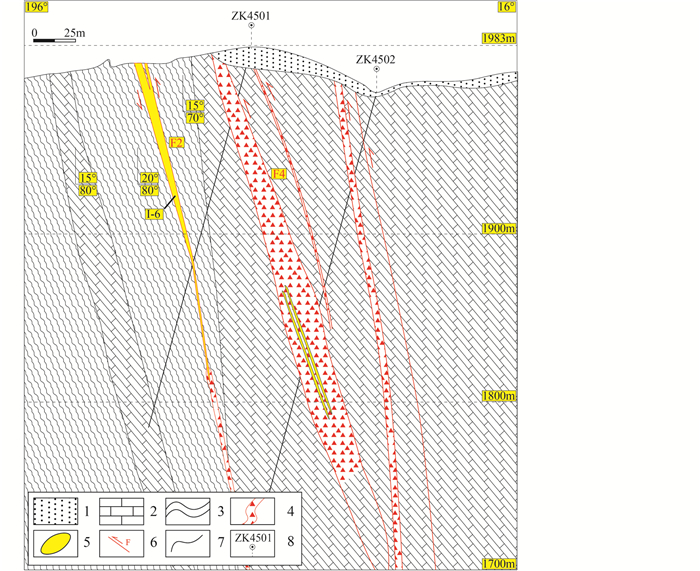
|
图 3 西秦岭安房坝金矿床45号勘探线剖面图(据甘肃省地矿局第一地质矿产勘查院, 2009修改) 1-第四系覆盖物;2-中三叠统隆务河群第二岩性段中层灰岩;3-中三叠统隆务河群第二岩性段薄层板岩;4-断层破碎带;5-金矿体;6-断层;7-地质界线;8-钻孔及编号 Fig. 3 Geological cross section of Line 45 in the Anfangba gold deposit, West Qinling |
区内发育的花岗闪长岩脉与金矿体关系密切,其中规模最大者位于I-6矿体以南,岩脉总体呈北西向展布,受北西向断裂控制,与金矿体紧密相伴(图 2)。呈脉状分布,地表出露长约1500m,一般宽数米,最宽处约20m,主要沿构造裂隙和层间断裂侵入,与围岩界线清楚,产状335°~20°∠50°~75°。蚀变较强,具金矿化,局部可达边界品位,而形成金矿体。
截止2009年底,安房坝金矿共探明金金属量9196kg,矿床平均品位3.00g/t,属中型金矿床(甘肃地矿局第一地质矿产勘查院, 2009)。夹持于区内F1与F2断裂之间的I-6、I-7矿体是该矿床的主矿体之一,两者均分布于矿区北部安场沟-田沟一带。其中I-6矿体受F2断裂控制,矿体为似层状,呈北西向展布,地表控制矿体长1517m,平均厚度1.50m,平均品位5.09g/t,矿体产状355°~50°∠50°~84°,沿走向具膨大缩小现象,与围岩呈断层接触,界线一般较清晰(图 3)。I-7矿体受F1断裂控制,矿体为似层状,呈北西向展布,地表控制矿体长580m,平均厚度1.56m,平均品位2.49g/t,矿体产状20°~50°∠80°~85°。矿体与围岩呈断层接触,界线清晰;顶板为灰岩、灰岩夹板岩等,底板为灰白色粉砂岩、泥灰岩、炭质板岩、板岩夹灰岩等(图 3)。
3 样品描述与分析方法本文分别选取安房坝金矿床中两类蚀变脉岩样品开展LA-ICP-MS锆石定年工作。其中AFB.20样品采自27勘探线、I-6矿体附近,具有金矿化(图 4a)。AFB.20岩石手标本整体淡乳黄白色(图 4b),具有中细粒花岗结构、鳞片状花岗变晶结构,块状构造,主要由石英(30%),斜长石(45%),钾长石(20%),黑云母(5%)组成(图 5a),蚀变矿物主要为脉状或浑圆状石英(60%)、绢云母(35%)、绿泥石(1%)、绿帘石、不透明矿物(主要为黄铁矿、毒砂,3%)和少量方解石组成(图 5b, c)。石英主要分为两类,一类为自形-半自形,粒径0.5~0.1mm,通常与斜长石、钾长石共生,应是早期岩浆结晶作用过程中的产物;另一类为他形,粒径0.05~0.10mm,呈镶嵌状与绢云母共同分布于早期形成的矿物颗粒之间,可能为热液蚀变过程中重结晶产物。绢云母以显微鳞片状,通常与蚀变矿物绿泥石、绿帘石共生,或以脉状交代早期形成的斜长石、钾长石等矿物,同样应为热液蚀变过程中的产物。部分绢云母矿物集合体保留了原矿物斜长石的斑状晶型外形,也有少量绢云母集合体保留了黑云母鳞片状结构特征,粒径约0.15~0.50mm×0.70~0.90mm(图 5d)。绿帘石、绿泥石等矿物在手标本中仅零星可见。黄铁矿、毒砂等矿石矿物主要产出于切穿岩脉的石英脉体中,也有部分黄铁矿呈浸染状分布。
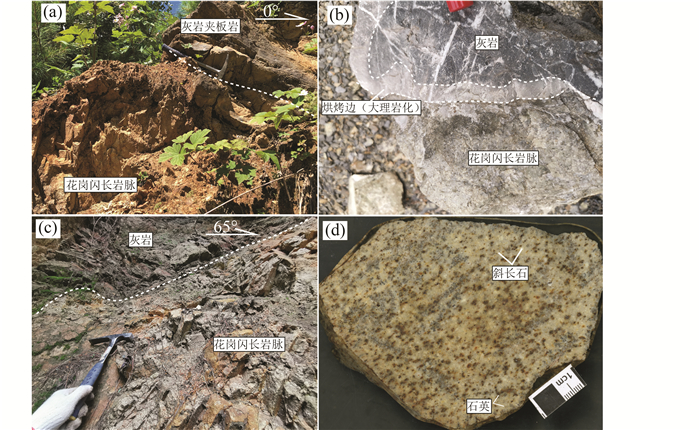
|
图 4 花岗闪长岩脉野外及手标本特征 (a)花岗闪长岩脉侵入上覆中三叠统隆务河群第一岩性段灰岩夹板岩地层之间,该岩脉局部含黄铁矿化及金矿化,AFB.20样品采样位置;(b)中三叠统隆务河群第一岩性段灰岩与花岗闪长岩脉接触边界有大理岩化烘烤边,花岗闪长岩脉中发育浸染状黄铁矿;(c)花岗闪长岩脉侵入中三叠统隆务河群第一岩性段灰岩地层,AFB.21样品采样位置;(d)花岗闪长岩样品手标本特征,褐铁矿化较强 Fig. 4 Field and hand specimen features of granodiorite dikes |

|
图 5 花岗闪长岩岩脉样品显微岩相学特征 (a)斜长石与钾长石遭受较强蚀变,仅保留晶型特征,未蚀变石英颗粒呈孤立状,单偏光;(b)样品中的玉髓-方解石细脉,正交偏光;(c)含金黄铁矿-石英-方解石脉,正交偏光;(d)鳞片状黑云母被绿泥石、绢云母、方解石交代.Qz-石英; Pl-斜长石; Kfs-钾长石; Chal-玉髓; Cal-方解石; Ser-绢云母; Py-黄铁矿; Chl-绿泥石 Fig. 5 Photomicrographs of the granodiorite samples |
AFB.21样品采自距离矿体较远的69勘探线附近,此处花岗闪长岩脉同样具有较强的蚀变(图 4c, d),但金矿化程度相对较低,未达到边界品位。与AFB.20相比,该件样品除缺少黄铁矿、毒砂、绿泥石、绿帘石化等与金矿化有关的矿物,剩余矿物组成与AFB.20基本相同。
野外采集了多件蚀变花岗闪长岩样品以用于全岩主量元素分析,该分析在北京大学造山带重点实验室完成,采用X射线荧光光谱仪(XRF)分析,精度优于5%,详细测试方法和分析流程见Gao et al. (2002)。
岩石样品通过破碎、浮选、电磁分选等方法筛选出单个颗粒锆石,然后在双目镜下挑选出晶体形态完整的锆石颗粒,该工作在首钢地质勘察院完成。挑选出的锆石制成环氧树脂靶,经过抛光后进行阴极发光拍照。根据两类样品的不同蚀变特征,本文有针对性地选取了不同类型的锆石样品进行测试工作,以期得到更加可靠、有意义的年龄数据。AFB.20样品由于蚀变较强,原生的岩浆锆石普遍遭受较强热液蚀变,因此该样品主要针对其中具有典型热液特征的锆石进行测年工作以获得热液活动的年龄。AFB.21样品蚀变程度较弱,该样品中的锆石部分发育典型岩浆锆石的震荡环带,部分具有热液锆石暗色增生边结构,因此分别对以上两类锆石进行了锆石年龄测定。
锆石U-Pb同位素定年和微量元素含量分析在武汉上谱分析科技有限责任公司利用LA-ICP-MS同时分析完成。详细的仪器参数和分析流程见Zong et al. (2017)。激光剥蚀系统由193nm准分子激光器和MicroLas光学系统组成,ICP-MS型号为Agilent 7700e。本次分析的激光束斑为30μm,U-Pb同位素定年和微量元素含量处理中采用锆石标准91500和玻璃标准物质NIST610作外标分别进行同位素和微量元素分馏校正。每个时间分辨分析数据包括大约20~30s空白信号和50s样品信号。对分析数据的离线处理(包括对样品和空白信号的选择、仪器灵敏度漂移校正、元素含量及U- Pb同位素比值和年龄计算)采用软件ICPMSDataCal(Liu et al., 2008, 2010)完成。锆石样品的U-Pb年龄谐和图绘制和年龄加权平均计算采用Isoplot/Ex_ver3(Ludwig, 2003)完成。锆石Lu-Hf同位素分析在天津地质矿产研究所实验室的193nm激光剥蚀系统(New Wave)和多接收器电感耦合等离子体质谱仪(MC-ICP-MS, Neptune)上完成。详细的仪器参数、分析流程及同位素分馏校正可参见Geng et al. (2017)。
4 分析结果 4.1 全岩主量元素分析全岩主量元素分析结果见表 2。在TAS岩石分类图解上(图 6),安房坝金矿床中6件蚀变花岗闪长岩样品主体落入花岗闪长岩区。其中靠近主矿体的3件花岗闪长岩样品(AFB.20(1)~AFB.20(3))主量元素组成为SiO2=62.86%~70.18%、Al2O3=14.39%~19.87%、Fe2O3T=0.80%~1.29%、MgO=0.28%~0.35%、CaO=0.65%~1.08%、Na2O+K2O=4.32%~5.81%。远离矿体的3件花岗闪长岩样品(AFB.21(1)~AFB.21(3))主量元素组成为SiO2=68.76%~72.76%、Al2O3=16.93%~19.88%、Fe2O3T=1.18%~1.76%、MgO=0.33%~0.41%、CaO=0.40%~1.29%、Na2O+K2O=3.98%~5.10%。值得注意的是,靠近矿体的花岗闪长岩样品PbO含量较高(3.78%~5.29%),远离矿体的花岗闪长岩样品则不具有PbO,这可能与靠近矿体的岩体遭受矿化蚀变有关。由于6件用于全岩主量分析的样品具有较高的烧失量(2.70%~4.73%),因此本文利用哈克图解对TAS图解中使用的SiO2、Na2O+K2O与LOI进行了相关性判别(图 7),结果显示SiO2、Na2O+K2O与LOI无相关性,这表明烧失量对TAS图解影响较小。
|
|
表 2 安房坝金矿床蚀变花岗闪长岩脉主量元素分析结果(wt%) Table 2 Major elements analyze of the altered granodiorite dikes in the Anfangba gold deposit (wt%) |

|
图 6 安房坝金矿床中蚀变花岗闪长岩(Na2O+K2O)-SiO2分类图解(据Middlemost, 1994) 1-橄榄辉长岩;2a-碱性辉长岩;2b-亚碱性辉长岩;3-辉长闪长岩;4-闪长岩;5-花岗闪长岩;6-花岗岩;7-硅英岩;8-二长辉长岩;9-二长闪长岩;10-二长岩;11-石英二长岩;12-正长岩;13-副长石辉长岩;14-副长石二长闪长岩;15-副长石二长正长岩;16-副长正长岩;17-副长深成岩;18-霓方钠岩/磷霞岩/粗白榴岩 Fig. 6 Na2O+K2O vs. SiO2 diagrams of the altered granodiorite dikes in the Anfangba gold deposit (modified by Middlemost, 1994) |
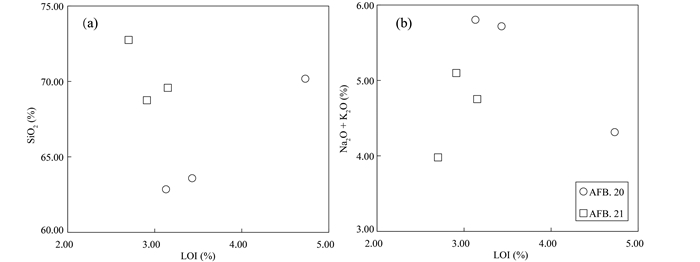
|
图 7 安房坝花岗闪长岩体主量元素哈克图解 Fig. 7 Harker diagrams of the altered granodiorite dikes in the Anfangba gold deposit |
根据锆石形态特征、锆石微量元素特征,本文将两件样品中的锆石分为岩浆锆石、热液锆石两类。在CL图像下,岩浆锆石自形程度好,亮度高,具有明显的震荡环带(图 8)。而热液锆石通常围绕先存锆石的边部生长,形成典型的暗色增生边结构。AFB.20绝大多数锆石亮度极低,且发育暗色增生边结构(图 8b),与热液锆石特征相符(Hu et al., 2004; Hoskin, 2005)。AFB.21遭受蚀变程度弱于AFB.20,多颗锆石CL图像下明亮且内部结构均匀,发育震荡环带,具有岩浆锆石的特征(图 8c),剩余锆石与AFB.20中热液锆石特征基本一致。

|
图 8 安房坝花岗闪长岩样品中的部分典型锆石阴极发光图像 Fig. 8 Representative CL images for granodiorite zircons in the Anfangba gold deposit |
除了在锆石CL图像特征方面的差异,安房坝金矿床中两类锆石在微量元素组成方面也有显著的区分(表 3、表 4)。AFB.20样品中锆石普遍具有极高的普通铅含量,206Pb=0.03%~29.84%,平均值6.56%。热液锆石(1~20号测点)Th含量为73.2×10-6~13693×10-6,U含量为278×10-6~4846×10-6,Th/U比值为0.17~2.83,平均值0.67。∑LREE为15.3×10-6~3525×10-6,∑HREE为358.1×10-6~6728×10-6。AFB.20岩浆锆石(21号、22号测点)Th含量分别为30.5×10-6、30.6×10-6,U含量为85.5、85.7×10-6,Th/U比值均为0.36,∑LREE分别为3.2×10-6、3.2×10-6,∑HREE分别为121.9×10-6、119.0×10-6(表 3)。以上两组锆石的球粒陨石标准化稀土元素配分模式具有显著的差异(图 9),热液锆石(1~20号测点)LREE富集,稀土配分曲线平缓,Ce正异常特征不明显(Ce/Ce*=0.5~3.7),Eu总体呈弱正异常(Eu/Eu*=0.5~1.9);岩浆锆石(21号、22号测点)LREE亏损明显,HREE富集,且具有显著的Ce正异常(Ce/Ce*值分别为109、73.2),Eu弱负异常(Eu/Eu*值分别为0.78、0.94)。
|
|
表 3 安房坝金矿床蚀变花岗闪长岩脉中锆石稀土元素分析结果(×10-6) Table 3 Zircon REE composition of altered granodiorite dikes in the Anfangba gold deposit (×10-6) |
|
|
表 4 安房坝金矿床蚀变花岗闪长岩脉中锆石U-Pb分析结果 Table 4 Zircon U-Pb isotopic data obtained by LA-ICP-MS of altered granodiorites in the Anfangba gold deposit |
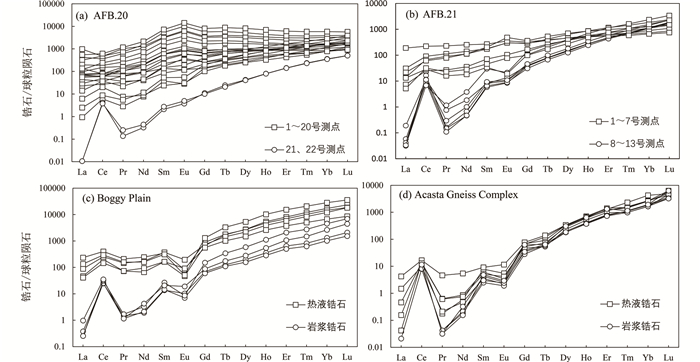
|
图 9 安房坝金矿床花岗闪长岩脉中不同性质锆石的球粒陨石标准化稀土元素配分曲线(标准化值据McDonough and Sun, 1995) (a) AFB.20样品中锆石;(b) AFB.21样品中锆石;(c) Boggy Plain岩体锆石(数据引自Hoskin, 2005);(d) Acasta Gneiss Complex岩体锆石(数据引自Rayner et al., 2005) Fig. 9 Chondrite normalized REE patterns of granodiorite zircons in the Anfangba gold deposit (normalization values after McDonough and Sun, 1995) |
AFB.21锆石中的普通铅含量较低,206Pb为0~0.02%,且热液锆石(1~7号测点)(206Pb=0.0001%~0.02%,均值0.01%)高于岩浆锆石(8~13号测点)(206Pb=0~0.001%,均值0.0004%)。热液锆石(1~7号测点)Th含量为154×10-6~757×10-6,U含量为991×10-6~1791×10-6,Th/U比值为0.15~0.53,平均值0.30,∑LREE为36.9×10-6~382.1×10-6,∑HREE为462.6×10-6~885.4×10-6。岩浆锆石(8~13号测点)Th含量为35.8×10-6~156×10-6,U含量为300×10-6~801×10-6,Th/U比值为0.12~0.19,平均值0.16,∑LREE为7.1×10-6~12.2×10-6,∑HREE为371.3×10-6~541.2×10-6。在稀土元素配分模式图上,两组锆石同样具有显著差异(图 9),热液锆石(1~7号测点)LREE富集,Ce正异常特征不明显(Ce/Ce*=1.07~2.93),Eu总体呈轻微正异常(Eu/Eu*=0.32~1.79)。岩浆锆石(8~13号测点)LREE亏损,且具有显著的Ce正异常(Ce/Ce*=30.3~229),Eu弱负异常(Eu/Eu*=0.33~0.76)(表 3)。
4.4 锆石U-Pb年龄通过锆石CL图像及锆石微量元素特征,本文甄别了两类蚀变岩体中的岩浆与热液锆石,并在此基础上开展了锆石LA-ICP-MS测年工作,测试数据见表 4。由于AFB.20已发生强烈矿化,该样品中的锆石遭受后期热液改造特征明显,典型的岩浆锆石几乎不可见。共计22颗锆石进行了U-Pb年龄及锆石微量元素的测定,其中1~20号测点为热液锆石,21、22号测点为岩浆锆石。由于岩浆锆石样本数量少,故仅用作微量元素对比,不参与年龄成图。考虑到AFB.20锆石中极高的普通铅含量,本文采用Tera-Wasserburg图解法进行了普通铅校正(郝爽等, 2016),207Pb/208Pb与238U/206Pb比值通过拟协和图法处理后,得到下交点年龄为224.2±6.1Ma(MSWD=0.65, n=20)(图 10)。
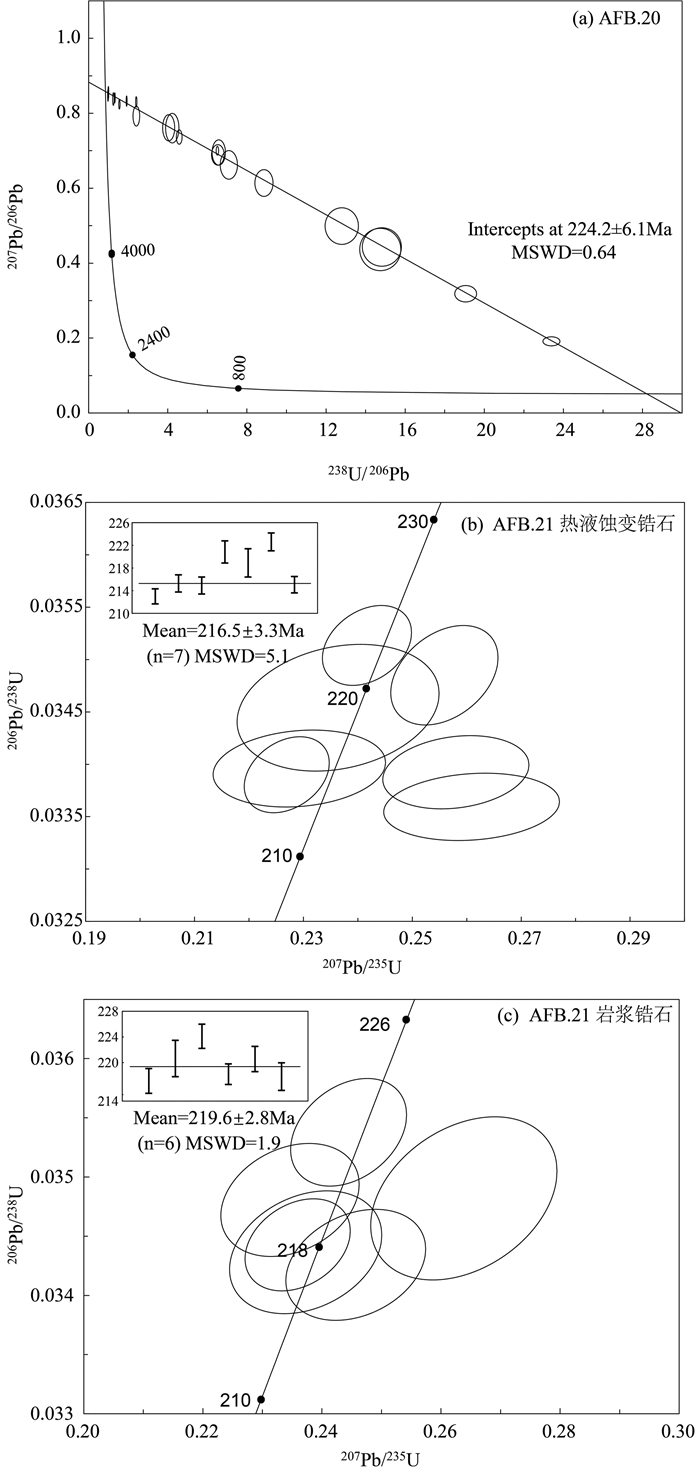
|
图 10 蚀变花岗闪长岩样品锆石U-Pb年龄协和图 Fig. 10 Concordia diagrams of zircons from altered granodiorite dikes in the Anfangba gold deposit |
AFB.21样品遭受矿化蚀变程度低,锆石中普通铅含量维持于正常水平,故采用协和图法与加权平均法限定锆石年龄。其中1~7号锆石具有典型的热液锆石特征,获得的206Pb/238U加权平均年龄216.5±3.3Ma(MSWD=5.1, n=7),8~13号岩浆锆石获得206Pb/238U加权平均年龄219.6±2.8Ma(MSWD=1.9, n=6)(图 10)。
4.5 锆石Hf同位素在锆石U-Pb定年基础上,对AFB.20中20颗及AFB.21中13颗不同成因锆石分别进行了Hf同位素分析(表 5)。AFB.20热液锆石(1~19号测点)(176Hf/177Hf)i范围为0.282217~0.282562,代入t=224.2Ma求得εHf(t)值为-2.5~-14.7,二阶段模式年龄tDM2=1913~3006Ma(表 5;图 11);AFB.20岩浆锆石(20号测点)(176Hf/177Hf)i为0.282379,代入t=224.2Ma求得εHf(t)值为-9.0,二阶段模式年龄tDM2=2495Ma。AFB.21热液锆石(1~7号测点)(176Hf/177Hf)i范围为0.282351~0.282514,代入t=216.5Ma求得εHf(t)值为-4.4~-10.2,二阶段模式年龄tDM2=2074~2592Ma;AFB.21热液锆石(8~13号测点)(176Hf/177Hf)i范围为0.282190~0.282515,代入t=219.6Ma求得εHf(t)值为-4.3~-15.8,二阶段模式年龄tDM2=2068~3097Ma(表 5;图 11)。
|
|
表 5 安房坝金矿床蚀变花岗闪长岩脉锆石Hf同位素分析结果 Table 5 Zircon Hf isotopic data obtained by LA-ICP-MS of altered granodiorite dikes in the Anfangba gold deposit |

|
图 11 安房坝金矿床蚀变岩脉锆石Hf同位素组成 Fig. 11 Hf isotopes of zircons from altered granodiorite dikes in the Anfangba gold deposit |
在CL图像下,AFB.20样品21~22号和AFB.21样品8~13号锆石具有清晰的震荡环带且有较高的亮度,这些特征与典型的岩浆锆石特征相符(陆松年和李怀坤, 1999)。热液锆石往往具有典型的暗色增生边核幔结构(吴元保和郑永飞, 2004),其核部为均有较高亮度的岩浆锆石,幔部则为几乎不发光的热液锆石增生体,这种不发光的原因可能与这些锆石中较高的Th、U以及普通铅含量有关(Watson et al., 1997; Hu et al., 2004)。本文AFB.20.1~20号锆石、AFB.21.1~7号锆石样品具有热液锆石的CL特征。样品中的热液锆石多数自形程度高,边界平直,没有遭受热交代蚀变的痕迹,应是岩浆热液晚期结晶作用的产物。在锆石稀土元素配分图解上,AFB.20.1~20和AFB.21.1~7号测点均富集轻稀土,稀土配分曲线相对较为平缓,且无Ce正异常,这些特征与Boggy Plain、Acasta Gneiss Complex矿床中典型热液锆石特征相符(Hoskin, 2005; Rayner et al., 2005)。相比较而言,AFB.20.21~22和AFB.21.8~13号锆石稀土元素配分则具有明显左倾趋势,具有显著的Ce正异常,与典型岩浆锆石稀土配分模式一致(吴元保和郑永飞, 2004)。热液锆石具有比岩浆锆石更高的Th、U含量(Geisler et al., 2003; Hoskin, 2005; Pelleter et al., 2007),在锆石Th-U关系图解中,可见AFB.20.1~20号测点Th、U含量均高于21、22测点,AFB.21.1~7号测点Th、U含量同样明显高于8~13测点(图 12)。在La (×10-6)-(Sm/La)N与(Sm/La)N-Ce/Ce*判别图解上,AFB.20.1~20号测点投入了靠近热液成因锆石的区域,而21、22号测点则落入或接近岩浆锆石的区域(图 13)。AFB.21两组数据在La (×10-6)-(Sm/La)N与(Sm/La)N-Ce/Ce*判别图解上同样表现出很大的差异,其1~7号测点落入热液成因锆石区,而8~13号测点则落入岩浆成因锆石区域(图 13)。综合以上分析表明,AFB.20.1~20和AFB.21.1~7样品在CL图像特征、稀土元素、微量元素(Th、U、206Pb含量)等方面均与热液锆石特征一致,而AFB.20.21~22和AFB.20.8~13号锆石在以上方面均与岩浆锆石的特征相符。

|
图 12 安房坝金矿床蚀变岩脉锆石Th-U关系图解 Fig. 12 Zircon Th vs. U diagrams of altered granodiorite dikes in the Anfangba gold deposit |

|
图 13 安房坝金矿床蚀变岩脉锆石微量元素判别图解 Fig. 13 Zircon trace-element ratio plots of altered granodiorite dikes in the Anfangba gold deposit |
对于热液锆石的研究表明,锆石可以直接从中低温热液流体中直接结晶(Kerrich and King, 1993; Rubin et al., 1993),也可以沿着原生锆石的边缘或裂隙对其进行交代,从而导致被交代部分的锆石U-Pb时钟体系重置,从而记录热液活动的年龄(Claoué-Long et al., 1990; Rubin et al., 1993)。如Claoué-Long et al. (1990)及Kerrich and King R (1993)对加拿大Abitibi矿床石英脉中的锆石研究表明,这些锆石结晶温度为260~380℃,这与该矿床中石英、自然金等矿物结晶温度相同,因此热液锆石可以与含金石英脉具有相似的成矿温压条件,这表明与金矿化有关的蚀变岩石中的热液锆石U-Pb同位素定年可以用来约束金矿床的形成时代(Hu et al., 2004)。AFB.20样品20颗热液锆石逆协和图解法得到下交点年龄为224.2±6.1Ma(MSWD=0.65, n=20),这可能代表了与花岗闪长岩体侵位有关的岩浆期后热液活动的时间。AFB.21.8~13号岩浆锆石206Pb/238U加权平均年龄为219.6±2.8Ma(MSWD=1.9, n=6),该锆石U-Pb年龄大致代表了花岗闪长岩脉体的侵位时间。1~7号热液锆石206Pb/238U加权平均年龄216.5±3.3Ma(MSWD=5.1, n=7),该年龄与AFB.20.1~20热液锆石所代表的年龄意义相同。安房坝金矿床中热液增生锆石与岩浆锆石Hf同位素组成接近,表明两种成因的锆石具有相似的源区,此结果进一步证明样品中的热液增生锆石是岩浆热液作用结晶的产物。在Hf同位素模式投图中两者均落入下地壳演化线附近,tDM2在1917~3097Ma之间,表明热液锆石与岩浆锆石Hf同位素可能均来源于太古代-古元古代的古老地壳物质重熔岩浆分异晚期(Wang et al., 2021)。岩浆分异晚期,热液锆石可能形成于流体饱和的岩浆中或形成于矿化花岗岩的流体中(Schaltegger, 2007),因此安房坝金矿床蚀变岩脉内热液锆石与岩浆锆石相近的年龄与相似的Hf同位素组成特征表明这些锆石可能正是同源岩浆活动演化的结果。
5.3 安房坝金矿床蚀变花岗闪长岩体与金矿化的关系安房坝蚀变花岗闪长质脉体是该矿床最重要的找矿标志之一,它在空间上与金矿体密切相伴,并在局部发生金矿化(尹刚和王蒙, 2019),这表明该岩体的成岩年龄可以用来约束安房坝金矿床成矿作用发生的上限。岩浆热液来源于岩浆结晶分异作用晚期所分泌出来的气水溶液(翟裕生等, 2011),安房坝金矿床花岗闪长岩脉体中岩浆锆石发育热液增生边结构,且相似的年龄及Hf同位素组成表明这些岩浆和热液锆石可能来源于同一岩浆作用。事实上,位于安房坝金矿床与崖湾锑矿之间存在清晰的剩余重力异常反射特征,这种反射特征对于隐伏岩体的指示作用,目前在整个西秦岭地区已经获得证实,根据剩余重力异常特征推断隐伏岩体与安房坝金矿床垂向距离可能小于5km,该隐伏岩体可能控制了区内崖湾、大桥、安房坝等矿床的形成(甘肃省地质调查院, 2010①)。安房坝金矿床中蚀变花岗闪长岩脉体中的热液锆石与隐伏岩体,以及热液锆石所代表的热液活动与矿区内的金矿化的关系值得进一步研究与探讨。
①甘肃省地质调查院. 2010. 甘肃崖湾-大桥金锑矿整装勘查区专项填图与技术应用示范子项目重点工作区找矿预测研究报告
6 结论(1) 安房坝金矿床矿区内花岗闪长岩形成时代为219Ma,属晚三叠世,与区内广泛发育的晚印支期岩浆活动一致,是西秦岭造山带同碰撞或碰撞后造山作用的产物。
(2) 锆石CL、微量元素研究表明,本文识别出了该蚀变岩体内的热液锆石,这些热液锆石通常以增生边的形式围绕岩浆锆石生长。通过对热液锆石定年,安房坝金矿区存在224~217Ma之间的热液活动,在误差范围内与花岗闪长岩成岩时代基本一致。
(3) 锆石Hf同位素研究表明,蚀变闪长岩体内热液锆石与岩浆锆石具有一致的源区,均来自于太古代-古元古代的古老地壳物质重熔,这表明两类锆石应是同一岩浆作用不同演化阶段的产物。
致谢 感谢甘肃地质调查院对本文野外工作提供的帮助与支持;感谢北京大学造山带重点实验室、武汉上谱分析科技有限责任公司、天津地质矿产研究所实验室实验人员在全岩主量元素分析、锆石U-Pb定年及Hf同位素分析中提供的帮助;两位匿名审稿专家为本文提供了宝贵的修改建议,在此致以衷心的感谢。
Bi SJ, Li JW and Zhao XF. 2008. Hydrothermal zircon U-Pb dating and geochronology of quartz vein-type gold deposits: A review. Geological Science and Technology Information, 27(1): 69-76 (in Chinese with English abstract)
|
Bo HJ. 2014. Genetic mineralogy and deep prospects of Anfangba gold deposit in Longnan, Gansu Province. Master Degree Thesis. Beijing: China University of Geosciences (Beijing), 1-78 (in Chinese with English summary)
|
Chen YJ, Zhang J, Zhang FX, Pirajno F and Li C. 2004. Carlin and Carlin-like gold deposits in western Qinling Mountains and their metallogenic time, tectonic setting and model. Geological Review, 50(2): 134-152 (in Chinese with English abstract)
|
Chen YJ. 2010. Indosinian tectonic setting, magmatism and metallogenesis in Qinling orogen, central China. Geology in China, 37(4): 854-865 (in Chinese with English abstract)
|
Cheng F. 2016. Studies on material composition and genesis of the Shuangwang gold deposit, Shaanxi Province. Master Degree Thesis. Beijing: China University of Geosciences (Beijing) (in Chinese with English summary)
|
Claoué-Long JC, King RW and Kerrich R. 1990. Archaean hydrothermal zircon in the Abitibi greenstone belt: Constraints on the timing of gold mineralisation. Earth and Planetary Science Letters, 98(1): 109-128 DOI:10.1016/0012-821X(90)90091-B
|
Corfu F, Hanchar JM, Hoskin PWO and Kinny P. 2003. Atlas of zircon textures. Reviews in Mineralogy and Geochemistry, 53(1): 496-500
|
Dong YP and Santosh M. 2016. Tectonic architecture and multiple orogeny of the Qinling orogenic belt, central China. Gondwana Research, 29(1): 1-40 DOI:10.1016/j.gr.2015.06.009
|
Douglas N, Mavrogenes J, Hack A and England R. 2000. The liquid bismuth collector model: An alternative gold deposition mechanism. In: Proceedings of the 15th Australian Geological Convention. Sydney: 135
|
Gao S, Liu XM, Yuan HL, Hattendorf B, Günther D, Chen L and Hu SH. 2002. Determination of forty two major and trace elements in USGS and NIST SRM glasses by laser ablation-inductively coupled plasma-Mass Spectrometry. Geostandards Newsletter, 26(2): 181-196 DOI:10.1111/j.1751-908X.2002.tb00886.x
|
Geisler T, Pidgeon RT, Kurtz R, van Bronswijk W and Schleicher H. 2003. Experimental hydrothermal alteration of partially metamict zircon. American Mineralogist, 88(10): 1496-1513 DOI:10.2138/am-2003-1013
|
Geng JZ, Qiu KF, Gou ZY and Yu HC. 2017. Tectonic regime switchover of Triassic Western Qinling Orogen: Constraints from LA-ICP-MS zircon U-Pb geochronology and Lu-Hf isotope of Dangchuan intrusive complex in Gansu, China. Geochemistry, 77(4): 673-651
|
Goldfarb RJ, Qiu KF, Deng J, Chen YJ and Yang LQ. 2019. Orogenic gold deposits of China. SEG Special Publications, 22: 263-324
|
Gou ZY, Yu HC, Qiu KF, Geng JZ, Wu MQ, Wang YG, Yu MH and Li J. 2019. Petrogenesis of ore-hosting diorite in the Zaorendao gold deposit at the Tongren-Xiahe-Hezuo polymetallic district, West Qinling, China. Minerals, 9(2): 76 DOI:10.3390/min9020076
|
Han YG, Zhang SH, Pirajno F and Zhang YH. 2007. Evolution of the Mesozoic granites in the Xiong'ershan-Waifangshan region, western Henan Province, China, and its tectonic implications. Acta Geologica Sinica, 81(2): 253-265 DOI:10.1111/j.1755-6724.2007.tb00949.x
|
Han YG, Zhang SH, Pirajno F, Zhou XW, Zhao GC, Qü WJ, Liu SH, Zhang JM, Liang HB and Yang K. 2013. U-Pb and Re-Os isotopic systematics and zircon Ce4+/Ce3+ ratios in the Shiyaogou Mo deposit in eastern Qinling, central China: Insights into the oxidation state of granitoids and Mo (Au) mineralization. Ore Geology Reviews, 55: 29-47 DOI:10.1016/j.oregeorev.2013.04.006
|
Hao S, Li HM, Li GZ, Geng JZ, Zhou HY, Xiao ZB, Cui YR and Tu JR. 2016. The comparison of the principle and applicability between two methods of deducting the initial common lead for in situ LA-ICP-MS U-Pb isotope dating of cassiterite. Geological Bulletin of China, 35(4): 622-632 (in Chinese with English abstract)
|
Heberer B, Anzenbacher T, Neubauer F, Genser J, Dong YP and Dunkl I. 2014. Polyphase exhumation in the western Qinling Mountains, China: Rapid early cretaceous cooling along a lithospheric-scale tear fault and pulsed Cenozoic uplift. Tectonophysics, 617: 31-43 DOI:10.1016/j.tecto.2014.01.011
|
Hoskin PWO and Schaltegger U. 2003. The composition of zircon and igneous and metamorphic petrogenesis. Reviews in Mineralogy and Geochemistry, 53(1): 27-62 DOI:10.2113/0530027
|
Hoskin PWO. 2005. Trace-element composition of hydrothermal zircon and the alteration of hadean zircon from the Jack Hills, Australia. Geochimica et Cosmochimica Acta, 69(3): 637-648 DOI:10.1016/j.gca.2004.07.006
|
Hu FF, Fan HR, Yang JH, Wan YS, Liu DY, Zhai MG and Jin CW. 2004. Mineralizing age of the Rushan lode gold deposit in the Jiaodong Peninsula: SHRIMP U-Pb dating on hydrothermal zircon. Chinese Science Bulletin, 49(15): 1629-1636 DOI:10.1007/BF03184134
|
Huang YQ, Qiu KF, Yu HC, Jin DG, He DY, Xiao CH and Wang YX. 2020. Petrogenesis of ore-hosting porphyry in the Gelouang gold deposit, West Qinling and its geological implications. Acta Petrologica Sinica, 36(5): 1567-1585 (in Chinese with English abstract) DOI:10.18654/1000-0569/2020.05.15
|
Ke CH, Wang XX, Yang Y, Tian YF, Li JB, Nie ZR, Lü XQ, Wang SN and Gong QM. 2020. Petrogenesis of dykes and its relationship to gold mineralization in the western Qinling belt: Constraints from zircon U-Pb age, geochemistry and Nd-Hf-S isotopes of Liba gold deposit. Mineral Deposits, 39(1): 42-62 (in Chinese with English abstract)
|
Kerrich R and King R. 1993. Hydrothermal zircon and baddeleyite in Val-d'or Archean mesothermal gold deposits: Characteristics, compositions, and fluid-inclusion properties, with implications fortiming of primary gold mineralization. Canadian Journal of Earth Sciences, 30(12): 2334-2351 DOI:10.1139/e93-203
|
Li CM. 2009. A review on the minerageny and situ microanalytical dating techniques of zircons. Geological Survey and Research, 32(3): 161-174 (in Chinese with English abstract)
|
Li LJ, Li TJ and Wang D. 2019. Calcite Sm-Nd isochron age of the Dashui gold deposit in West Qinling Orogenic Belt and its implications. Geoscience, 33(3): 469-475 (in Chinese with English abstract)
|
Li N, Deng J, Yang LQ, Goldfarb RJ, Zhang C, Marsh E, Lei SB, Koenig A and Lowers H. 2014. Paragenesis and geochemistry of ore minerals in the epizonal gold deposits of the Yangshan gold belt, West Qinling, China. Mineralium Deposita, 49(4): 427-449 DOI:10.1007/s00126-013-0498-8
|
Liu JJ, Zheng MH, Liu JM, Zhou YF, Gu XX and Zhang B. 1997. Geotectonic evolution and mineralization zone of gold deposits in western Qinling. Geotectonica et Metallogenia, 21(4): 307-314 (in Chinese with English abstract)
|
Liu JJ, Dai HZ, Zhai DG, Wang JP, Wang YH, Yang LB, Mao GJ, Liu XH, Liao YF, Yu C and Li QZ. 2015. Geological and geochemical characteristics and formation mechanisms of the Zhaishang Carlin-like type gold deposit, western Qinling Mountains, China. Ore Geology Reviews, 64: 273-298 DOI:10.1016/j.oregeorev.2014.07.016
|
Liu Y. 2013. Relationship between intermediate-acid dike rock and gold mineralizati on of the Zaozigou gold deposit, Gansu Province. Master Degree thesis. Xi'an: Chang'an University (in Chinese with English summary)
|
Liu YG, Lü XB, Zhang ZJ, You GJ, Cao XF, Wang YQ and Liu G. 2011. Genesis of Daqiao gold deposit in Xihe County, Gansu Province. Mineral Deposits, 30(6): 1085-1099 (in Chinese with English abstract)
|
Liu YH, Han YX, Wei JZ, Teng F, Tian RQ and Gao ZY. 2018. Geological and geochemical characteristics and prospecting potential of the Daqiao hot spring-type gold deposit in the West Qinling orogen. Geological Journal, 53(Suppl.1): 136-146
|
Liu YS, Hu ZC, Gao S, Günther D, Xu J, Gao CG and Chen HH. 2008. In situ analysis of major and trace elements of anhydrous minerals by LA-ICP-MS without applying an internal standard. Chemical Geology, 257(1-2): 34-43 DOI:10.1016/j.chemgeo.2008.08.004
|
Liu YS, Gao S, Hu ZC, Gao CG, Zong KQ and Wang DB. 2010. Continental and oceanic crust recycling-induced melt-peridotite interactions in the Trans-North China orogen: U-Pb dating, Hf isotopes and trace elements in zircons from mantle xenoliths. Journal of Petrology, 51(1-2): 537-571 DOI:10.1093/petrology/egp082
|
Lu SN, Li HK and Li HM. 1999. Research on isotopic geochronology of mineralization events. Earth Science Frontiers, 6(2): 335-342 (in Chinese with English abstract)
|
Ludwig KR. 2003. Isoplot 3.00: A Geochronological Toolkit for Microsoft Excel. Berkeley: Berkeley Geochronology Center, 39
|
Mao JW, Qiu YM, Goldfarb RJ, Zhang ZC, Garwin S and Ren FS. 2002. Geology, distribution, and classification of gold deposits in the western Qinling belt, central China. Mineralium Deposita, 37(3-4): 352-377 DOI:10.1007/s00126-001-0249-0
|
Mao JW, Xie GQ, Pirajno F, Ye HS, Wang YB, Li YF, Xiang JF and Zhao HJ. 2010. Late Jurassic-Early Cretaceous granitoid magmatism in eastern Qinling, central-eastern China: SHRIMP zircon U-Pb ages and tectonic implications. Australian Journal of Earth Sciences, 57(1): 51-78 DOI:10.1080/08120090903416203
|
McDonough WF and Sun SS. 1995. The composition of the Earth. Chemical Geology, 120(3-4): 223-253 DOI:10.1016/0009-2541(94)00140-4
|
Middlemost EAK. 1994. Naming materials in the magma/igneous rock system. Earth-Science Reviews, 37(3-4): 215-224 DOI:10.1016/0012-8252(94)90029-9
|
Pelleter E, Cheilletz A, Gasquet D, Mouttaqi A, Annich M, El Hakour A, Deloule E and Féraud G. 2007. Hydrothermal zircons: A tool for ion microprobe U-Pb dating of gold mineralization (Tamlalt-Menhouhou gold deposit-Morocco). Chemical Geology, 245(3-4): 135-161 DOI:10.1016/j.chemgeo.2007.07.026
|
Qi JZ, Yuan SS, Li L, Fan YX, Liu W, Gao QB, Sun B, Guo JH and Li ZH. 2003. Geological and geochemical studies of Yangshan gold deposit, Gansu Province. Mineral Deposits, 22(1): 24-31 (in Chinese with English abstract)
|
Qi JZ, Yang GC, Li L, Fan YX and Liu W. 2006. Isotope geochemistry, chronology and genesis of the Yangshan gold deposit, Gansu. Geology in China, 33(6): 1345-1353 (in Chinese with English abstract)
|
Qi YL, Zhang FX, Wang WT, Xiao L, Zhou TS, Li JB and Ren T. 2004. The characteristic contrast of geology and geochemistry in La'erma gold deposit and Xiajiadian gold deposit. Contributions to Geology and Mineral Resources Research, 19(4): 217-222 (in Chinese with English abstract)
|
Qiu KF, Yu HC, Gou ZY, Liang ZL, Zhang JL and Zhu R. 2018. Nature and origin of Triassic igneous activity in the Western Qinling Orogen: the Wenquan composite pluton example. International Geology Review, 60(2): 242-266 DOI:10.1080/00206814.2017.1334598
|
Qiu KF, Yu HC, Deng J, McIntire D, Gou ZY, Geng JZ, Chang ZS, Zhu R, Li KN and Goldfarb R. 2020a. The giant Zaozigou Au-Sb deposit in West Qinling, China: Magmatic- or metamorphic-hydrothermal origin?. Mineralium Deposita, 55(2): 345-362 DOI:10.1007/s00126-019-00937-w
|
Qiu KF, Yu HC, Hetherington C, Huang YQ, Yang T and Deng J. 2020b. Tourmaline composition and boron isotope signature as a tracer of magmatic-hydrothermal processes. American Mineralogist, doi: 10.2138/am-2021-7495
|
Rayner N, Stern RA and Carr SD. 2005. Grain-scale variations in trace element composition of fluid-altered zircon, Acasta Gneiss Complex, northwestern Canada. Contributions to Mineralogy and Petrology, 148(6): 721-734 DOI:10.1007/s00410-004-0633-8
|
Rubin JN, Henry CD and Price JG. 1993. The mobility of zirconium and other "immobile" elements during hydrothermal alteration. Chemical Geology, 110(1-3): 29-47 DOI:10.1016/0009-2541(93)90246-F
|
Schaltegger U. 2007. Hydrothermal Zircon. Elements, 3(1): 51-79 DOI:10.2113/gselements.3.1.51
|
Shan L, Zhang DM, Pan YC, Liu JJ, Zhang WY, Zhao XM and Zhang ZP. 2016. Late Triassic magmatic activity in the Daqiao gold deposit of West Qinling belt: Zircon U-Pb chronology and Lu-Hf isotope evidence. Geological Bulletin of China, 35(12): 2045-2057 (in Chinese with English abstract)
|
Shao SC and Wang DB. 2001. 39Ar-40Ar dating of the three typical gold deposits and its geological significance in the southern Qinling region. Acta Geologica Sinica, 75(1): 106-110 (in Chinese with English abstract)
|
Sui JX, Li JW, Jin XY, Vasconcelos P and Zhu R. 2018. 40Ar/39Ar and U-Pb constraints on the age of the Zaozigou gold deposit, Xiahe-Hezuo district, West Qinling orogen, China: Relation to Early Triassic reduced intrusions emplaced during slab rollback. Ore Geology Reviews, 101: 885-899 DOI:10.1016/j.oregeorev.2018.08.014
|
Sun WD, Li SG, Chen YD and Li YJ. 2002. Timing of synorogenic granitoids in the South Qinling, central China: Constraints on the evolution of the Qinling-Dabie orogenic belt. The Journal of Geology, 110(4): 457-468 DOI:10.1086/340632
|
Tooth B, Brugger J, Ciobanu C and Liu WH. 2008. Modeling of gold scavenging by bismuth melts coexisting with hydrothermal fluids. Geology, 36(10): 815-818 DOI:10.1130/G25093A.1
|
Tooth B, Ciobanu CL, Green L, O'Neill B and Brugger J. 2011. Bi-melt formation and gold scavenging from hydrothermal fluids: An experimental study. Geochimica et Cosmochimica Acta, 75(19): 5423-5443 DOI:10.1016/j.gca.2011.07.020
|
Wang J, Yu HC, He DY, Sun W, Wang YX, Liu PX and Qiu KF. 2021. Geochronology and geochemistry of the Yidi'nan quartz diorite in the West Qinling, China: Implications for evolution of the Palaeo-Tethys Ocean. Geological Journal, 56(4): 2277-2295 DOI:10.1002/gj.4055
|
Wang JP, Liu JJ, Carranza EJM, Liu ZJ, Liu CH, Liu BZ, Wang KX, Zeng XT and Wang H. 2015. A possible genetic model of the Shuangwang hydrothermal breccia gold deposit, Shaanxi Province, central China: Evidence from fluid inclusion and stable isotope. Journal of Asian Earth Sciences, 111: 840-852 DOI:10.1016/j.jseaes.2015.07.026
|
Wang XX, Wang T, Castro A, Pedreira R, Lu XX and Xiao QH. 2011. Triassic granitoids of the Qinling orogen, central China: Genetic relationship of enclaves and rapakivi-textured rocks. Lithos, 126(3-4): 369-387 DOI:10.1016/j.lithos.2011.07.007
|
Wang YT, Mao JW, Zhang J, Wang RT, Chen GM, Hu QQ, Chen SC and Liu XL. 2020. Geochronological constraints on the Baguamiao gold deposit, West Qinling orogen, central China: Implications for ore genesis and geodynamic setting. Ore Geology Reviews, 122: 103508 DOI:10.1016/j.oregeorev.2020.103508
|
Watson EB, Chemiak DJ, Hanchar JM, Harrison TM and Wark DA. 1997. The incorporation of Pb into zircon. Chemical Geology, 141(1-2): 19-31 DOI:10.1016/S0009-2541(97)00054-5
|
Wu YB and Zheng YF. 2004. Genesis of zircon and its constraints on interpretation of U-Pb age. Chinese Science Bulletin, 49(16): 1589-1604 (in Chinese) DOI:10.1360/csb2004-49-16-1589
|
Wu YF, Li JW, Evans K, Koenig AE, Li ZK, O'Brien H, Lahaye Y, Rempel K, Hu SY, Zhang ZP and Yu JP. 2018. Ore-forming processes of the Daqiao epizonal orogenic gold deposit, West Qinling orogen, China: Constraints from textures, trace elements, and sulfur isotopes of pyrite and marcasite, and Raman spectroscopy of carbonaceous material. Economic Geology, 113(5): 1093-1132 DOI:10.5382/econgeo.2018.4583
|
Wu YF, Li JW, Evans K, Vasconcelos PM, Thiede DS, Fougerouse D and Rempel K. 2019. Late Jurassic to early cretaceous age of the Daqiao gold deposit, West Qinling orogen, China: Implications for regional metallogeny. Mineralium Deposita, 54(4): 631-644 DOI:10.1007/s00126-018-0835-z
|
Yang DF. 2013. The geological characteristics and metallogenic model of Donggou-Jinlongshan gold deposits. Master Degree Thesis. Xi'an: Chang'an University (in Chinese with English summary)
|
Yang RS, Chen YJ, Zhang FX, Li ZH, Mao SD, Liu HJ and Zhao CH. 2006. Chemical Th-U-Pb ages of monazite from the Yangshan gold deposit, Gansu Province and their geologic and metallogenic implications. Acta Petrologica Sinica, 22(10): 2603-2610 (in Chinese with English abstract)
|
Yin G and Wang M. 2019. Geological characteristics and metallogenic model of the Anfangba gold deposit, Wudu, Gansu. Gansu Science and Technology, 35(9): 36-38 (in Chinese)
|
Yin Y. 2011. Relation of dike rock and gold mineralization in West Qinling region. Gansu Geology, 20(1): 28-37, 51 (in Chinese with English abstract)
|
Yu HC, Guo CA, Qiu KF, McIntire D, Jiang GP, Gou ZY, Geng JZ, Pang Y, Zhu R and Li NB. 2019. Geochronological and geochemical constraints on the formation of the giant Zaozigou Au-Sb deposit, West Qinling, China. Minerals, 9(1): 37 DOI:10.3390/min9010037
|
Yu HC, Qiu KF, Nassif MT, Geng JZ, Sai SX, Duo DW, Huang YQ and Wang J. 2020a. Early orogenic gold mineralization event in the West Qinling related to closure of the Paleo-Tethys Ocean: Constraints from the Ludousou gold deposit, central China. Ore Geology Reviews, 117: 103217 DOI:10.1016/j.oregeorev.2019.103217
|
Yu HC, Qiu KF, Sai SX, McIntire DC, Pirajno F, Duo DW, Miggins DP, Wang J, Jia RY and Wu MQ. 2020b. Paleo-Tethys Late Triassic orogenic gold mineralization recorded by the Yidi'nan gold deposit, West Qinling, China. Ore Geology Reviews, 116: 103211 DOI:10.1016/j.oregeorev.2019.103211
|
Yuan SS, Li WL, Zhang Y and Chang CJ. 2008. Metallogenic process and model of the super-large Yangshan gold deposit in Gansu Province. Geology and Resources, 17(2): 92-101 (in Chinese with English abstract)
|
Yue SW, Deng XH, Bagas L, Lin ZW, Fang J, Zhu CH and Zhang W. 2017. Fluid inclusion geochemistry and 40Ar-39Ar geochronology constraints on the genesis of the Jianchaling Au deposit, China. Ore Geology Reviews, 80: 676-690 DOI:10.1016/j.oregeorev.2016.08.024
|
Zeng QT, McCuaig TC, Hart CJR, Jourdan F, Muhling J and Bagas L. 2012. Structural and geochronological studies on the Liba goldfield of the West Qinling orogen, central China. Mineralium Deposita, 47(7): 799-819 DOI:10.1007/s00126-011-0398-8
|
Zeng QT, Evans NJ, McInnes BIA, Batt GE, McCuaig CT, Bagas L and Tohver E. 2013. Geological and thermochronological studies of the Dashui gold deposit, West Qinling orogen, central China. Mineralium Deposita, 48(3): 397-412 DOI:10.1007/s00126-012-0433-4
|
Zhai YS, Yao SZ and Cai KQ. 2011. Ore Deposit. Beijing: Geological Publishing House, 123-185 (in Chinese)
|
Zhang GW, Meng QR, Yu ZP, Sun Y, Zhou DW and Guo AL. 1996. The orogenic process and dynamic characteristics of the Qinling orogenic belt. Science in China (Series D), 26(3): 193-200 (in Chinese)
|
Zhang GW. 2001. Qinling Orogenic Belt and Continental Dynamics. Beijing: Science Press, 1-855 (in Chinese)
|
Zhang J, Li L, Gilbert S, Liu JJ and Shi WS. 2014. LA-ICP-MS and EPMA studies on the Fe-S-As minerals from the Jinlongshan gold deposit, Qinling Orogen, China: Implications for ore-forming processes. Geological Journal, 49(4-5): 482-500 DOI:10.1002/gj.2594
|
Zhang L, Qiu KF, Hou ZL, Pirajno F, Shivute E and Cai YW. 2021. Fluid-rock reactions of the Triassic Taiyangshan porphyry Cu-Mo deposit (West Qinling, China) constrained by QEMSCAN and iron isotope. Ore Geology Reviews, 132: 104068 DOI:10.1016/j.oregeorev.2021.104068
|
Zhao GC, He YH and Sun M. 2009. The Xiong'er volcanic belt at the southern margin of the North China craton: Petrographic and geochemical evidence for its outboard position in the Paleo-Mesoproterozoic Columbia Supercontinent. Gondwana Research, 16(2): 170-181 DOI:10.1016/j.gr.2009.02.004
|
Zhao ZH. 2010. Trace element geochemistry of accessory minerals and its applications in petrogenesis and metallogenesis. Earth Science Frontiers, 17(1): 267-286 (in Chinese with English abstract)
|
Zhu LM, Zhang GW, Li B, Guo B, Kang L and Lü SL. 2009. Geology, isotope geochemistry and ore genesis of the Maanqiao gold deposit, Shaanxi Province. Acta Petrologica Sinica, 25(2): 431-443 (in Chinese with English abstract)
|
Zong KQ, Klemd R, Yuan Y, He ZY, Guo JL, Shi XL, Liu YS, Hu ZC and Zhang ZM. 2017. The assembly of Rodinia: The correlation of Early Neoproterozoic (ca. 900Ma) high-grade metamorphism and continental arc formation in the southern Beishan orogen, southern Central Asian Orogenic Belt (CAOB). Precambrian Research, 290: 32-48
|
毕诗健, 李建威, 赵新福. 2008. 热液锆石U-Pb定年与石英脉型金矿成矿时代: 评述与展望. 地质科技情报, 27(1): 69-76. DOI:10.3969/j.issn.1000-7849.2008.01.012 |
薄海军. 2014. 甘肃陇南安房坝金矿成因矿物学研究与深部远景评价. 硕士学位论文. 北京: 中国地质大学(北京), 1-78
|
陈衍景, 张静, 张复新, Pirajno F, 李超. 2004. 西秦岭地区卡林-类卡林型金矿床及其成矿时间、构造背景和模式. 地质论评, 50(2): 134-152. DOI:10.3321/j.issn:0371-5736.2004.02.004 |
陈衍景. 2010. 秦岭印支期构造背景、岩浆活动及成矿作用. 中国地质, 37(4): 854-865. DOI:10.3969/j.issn.1000-3657.2010.04.003 |
程锋. 2016. 陕西省双王金矿床物质组成与矿床成因研究. 硕士学位论文. 北京: 中国地质大学(北京)
|
郝爽, 李惠民, 李国占, 耿建珍, 周红英, 肖志斌, 崔玉荣, 涂家润. 2016. LA-ICP-MS测定锡石U-Pb同位素年龄时两种普通铅扣除方法的原理及适用性比较. 地质通报, 35(4): 622-632. DOI:10.3969/j.issn.1671-2552.2016.04.019 |
黄雅琪, 邱昆峰, 于皓丞, 金鼎国, 何登洋, 肖昌浩, 王玉玺. 2020. 西秦岭格娄昂金矿床赋矿斑岩岩石成因及其地质意义. 岩石学报, 36(5): 1567-1585. |
柯昌辉, 王晓霞, 杨阳, 田永飞, 李金宝, 聂政融, 吕星球, 王顺安, 龚明权. 2020. 西秦岭地区脉岩成因与金成矿关系——来自李坝金矿年代学、地球化学及Nd-Hf-S同位素的约束. 矿床地质, 39(1): 42-62. |
李长民. 2009. 锆石成因矿物学与锆石微区定年综述. 地质调查与研究, 32(3): 161-174. DOI:10.3969/j.issn.1672-4135.2009.03.001 |
李林积, 李堂积, 王丹. 2019. 西秦岭大水金矿床方解石Sm-Nd等时线年龄及其地质意义. 现代地质, 33(3): 469-475. |
刘家军, 郑明华, 刘建明, 周渝峰, 顾雪祥, 张斌. 1997. 西秦岭大地构造演化与金成矿带的分布. 大地构造与成矿学, 21(4): 307-314. |
刘勇. 2013. 甘肃省枣子沟金矿中酸性脉岩与金成矿关系研究. 硕士学位论文. 西安: 长安大学
|
刘月高, 吕新彪, 张振杰, 尤关进, 曹晓峰, 王玉奇, 刘阁. 2011. 甘肃西和县大桥金矿床的成因研究. 矿床地质, 30(6): 1085-1099. DOI:10.3969/j.issn.0258-7106.2011.06.009 |
陆松年, 李怀坤, 李惠民. 1999. 成矿地质事件的同位素年代学研究. 地学前缘, 6(2): 335-342. DOI:10.3321/j.issn:1005-2321.1999.02.012 |
齐金忠, 袁士松, 李莉, 范永香, 刘伟, 高秋斌, 孙彬, 郭俊华, 李志宏. 2003. 甘肃省文县阳山金矿床地质地球化学研究. 矿床地质, 22(1): 24-31. DOI:10.3969/j.issn.0258-7106.2003.01.003 |
齐金忠, 杨贵才, 李莉, 范永香, 刘伟. 2006. 甘肃省阳山金矿床稳定同位素地球化学和成矿年代学及矿床成因. 中国地质, 33(6): 1345-1353. DOI:10.3969/j.issn.1000-3657.2006.06.018 |
齐亚林, 张复新, 王伟涛, 肖丽, 周铁锁, 李健斌, 任涛. 2004. 拉尔玛金矿床与夏家店金矿床地质地球化学特征对比. 地质找矿论丛, 19(4): 217-222. DOI:10.3969/j.issn.1001-1412.2004.04.001 |
陕亮, 张东明, 庞迎春, 刘家军, 张万益, 赵辛敏, 张忠平. 2016. 西秦岭大桥金矿区晚三叠世岩浆活动——锆石U-Pb定年及Lu-Hf同位素证据. 地质通报, 35(12): 2045-2057. DOI:10.3969/j.issn.1671-2552.2016.12.012 |
邵世才, 汪东波. 2001. 南秦岭三个典型金矿床的Ar-Ar年代及其地质意义. 地质学报, 75(1): 106-110. |
吴元保, 郑永飞. 2004. 锆石成因矿物学研究及其对U-Pb年龄解释的制约. 科学通报, 49(16): 1589-1604. DOI:10.3321/j.issn:0023-074X.2004.16.002 |
杨登峰. 2013. 东沟-金龙山金矿矿床地质特征及成矿模式分析. 硕士学位论文. 西安: 长安大学
|
杨荣生, 陈衍景, 张复新, 李志宏, 毛世东, 刘红杰, 赵成海. 2006. 甘肃阳山金矿独居石Th-U-Pb化学年龄及其地质和成矿意义. 岩石学报, 22(10): 2603-2610. |
尹刚, 王蒙. 2019. 甘肃武都安房坝金矿床地质特征及成矿模式探讨. 甘肃科技, 35(9): 36-38. |
殷勇. 2011. 西秦岭地区脉岩与金矿化的关系. 甘肃地质, 20(1): 28-37, 51. |
袁士松, 李文良, 张勇, 常春郊. 2008. 甘肃省文县阳山超大型金矿床成矿作用及成矿模式. 地质与资源, 17(2): 92-101. DOI:10.3969/j.issn.1671-1947.2008.02.003 |
翟裕生, 姚书振, 蔡克勤. 2011. 矿床学. 北京: 地质出版社, 123-185.
|
张国伟, 孟庆任, 于在平, 孙勇, 周鼎武, 郭安林. 1996. 秦岭造山带的造山过程及其动力学特征. 中国科学(D辑), 26(3): 193-200. DOI:10.3321/j.issn:1006-9267.1996.03.001 |
张国伟. 2001. 秦岭造山带与大陆动力学. 北京: 科学出版社, 1-855.
|
赵振华. 2010. 副矿物微量元素地球化学特征在成岩成矿作用研究中的应用. 地学前缘, 17(1): 267-286. |
朱赖民, 张国伟, 李犇, 郭波, 康磊, 吕拾零. 2009. 陕西省马鞍桥金矿床地质特征、同位素地球化学与矿床成因. 岩石学报, 25(2): 431-443. |
 2021, Vol. 37
2021, Vol. 37











